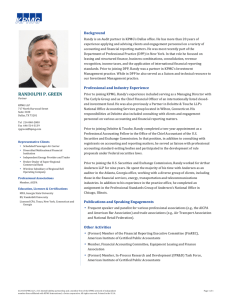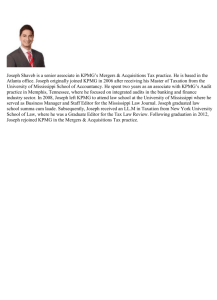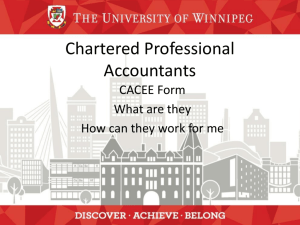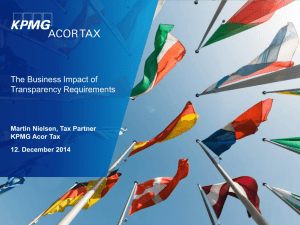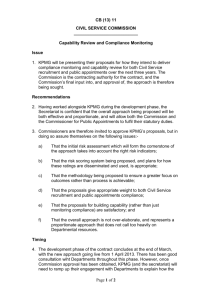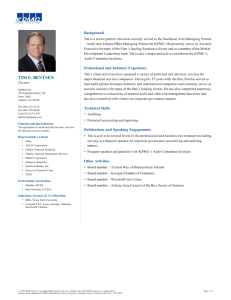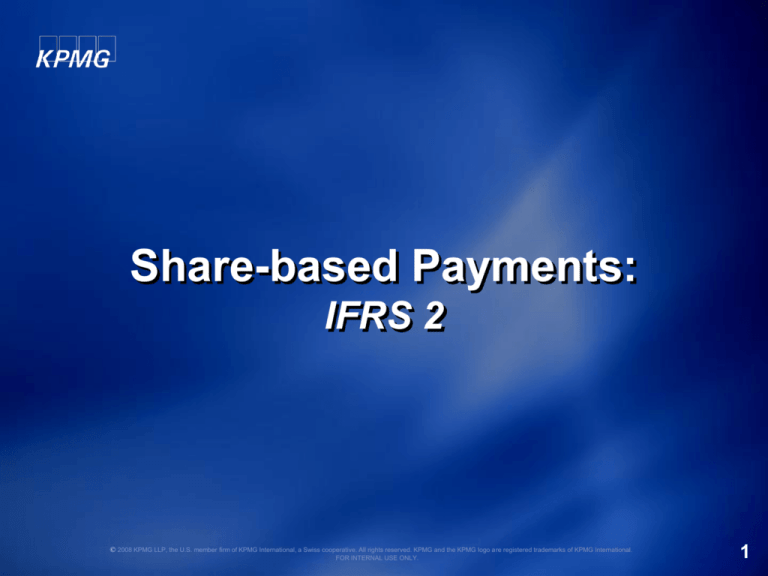
Share-based Payments:
IFRS 2
© 2008 KPMG LLP, the U.S. member firm of KPMG International, a Swiss cooperative. All rights reserved. KPMG and the KPMG logo are registered trademarks of KPMG International.
FOR INTERNAL USE ONLY.
1
General Recognition Principles of IFRS 2
Recognize goods or services received at fair value when the goods are
obtained or as services are received
When the goods or services do not qualify for recognition as assets, an
expense is recognized
For equity-settled share-based payment transactions a corresponding
increase in equity is recognized; and
For cash-settled share-based payment transactions a corresponding
liability is incurred
IFRS 2 contains specific requirements for:
Equity-settled (shares, share options, warrants)
Cash-settled (share appreciation rights)
Compound instrument containing both equity and cash-settled
components (bifurcate)
© 2008 KPMG LLP, the U.S. member firm of KPMG International, a Swiss cooperative. All rights reserved. KPMG and the KPMG logo are registered trademarks of KPMG International.
FOR INTERNAL USE ONLY.
2
Overview of Accounting Requirements of
IFRS 2
Equity-settled share-based payment transactions
Measure goods/services and corresponding increase in equity at FV of
goods/services received unless FV cannot be estimated reliably, then use
FV of equity instruments (usually the case for employee awards)
Use grant-date FV with no remeasurement in subsequent periods for
employee awards, but estimate and true-up for forfeitures
Cash-settled share-based payment transactions
Measure goods/services and the liability incurred at FV of the liability
Start with grant-date FV, but liability is remeasured at FV through P&L
until settlement (estimate and true-up for forfeitures)
Option of either equity-settled or cash-settled at holder’s election
Account for as a cash-settled transaction (a compound financial instrument
if settlement values differ) if entity has incurred a liability to settle in cash
© 2008 KPMG LLP, the U.S. member firm of KPMG International, a Swiss cooperative. All rights reserved. KPMG and the KPMG logo are registered trademarks of KPMG International.
FOR INTERNAL USE ONLY.
3
Recognition Example
Cash-settled Transaction
Vesting conditions:
Three year continued employment (service condition)
Assumptions:
100 stock appreciation rights granted on January 1, 20X1
Best estimate is that all employees remain in service over the
vesting period
Grant date fair value of each right is $3.00
Subsequent estimates of:
End year x1
End year x2
End year x3
Settlement date
Fair value
$4.00
$4.25
$4.50
$4.00
Intrinsic value
$1.50
$3.00
$4.25
$4.00
© 2008 KPMG LLP, the U.S. member firm of KPMG International, a Swiss cooperative. All rights reserved. KPMG and the KPMG logo are registered trademarks of KPMG International.
FOR INTERNAL USE ONLY.
4
IFRS and U.S. GAAP Differences:
Share-Based Payments: Classification
IFRS 2
Classification
Liability-classified if cash settled
(including at employee’s option)
Puttable shares always liabilityclassified unless contingently
puttable
Compound instrument if employee
has choice of settlement:
- liability component measured first
- balance is equity component
FAS 123R
Classification
Liability-classified if:
Grantor can be compelled to
deliver cash or other assets
No equity holder relationship
established (e.g., “other”
conditions, fixed monetary
amount awards)
Puttable shares equity-classified if
(a) employee has made a
substantial investment and bears
risks and rewards of ownership for
a “reasonable period” and (b)
redemption price is at FV
Generally liability classified unless
Case Study 1: Choice ofit settlement
is a tandem award
© 2008 KPMG LLP, the U.S. member firm of KPMG International, a Swiss cooperative. All rights reserved. KPMG and the KPMG logo are registered trademarks of KPMG International.
FOR INTERNAL USE ONLY.
5
IFRS and U.S. GAAP Differences:
Share-Based Payments: Grant date and Scope
FAS 123R
IFRS 2
Grant date
Date the entity and employee agree to a
share-based payment arrangement and have
a shared understanding of the terms and
conditions of the arrangement
Grant date
Date the employer and employee have a
mutual understanding of the terms and
conditions of the award and the employee
begins to benefit from or be adversely
affected by changes in the employer’s share
price
Scope
Applies to all share-based payment
arrangements
Scope
Applies to share-based payment
arrangements with employees and is applied
by analogy to share-based payment
arrangements with non-employees
We would expect a high degree of correlation
between the calculation of the award and the
share price for a transaction to be classified a
share-based payment
A transaction that is based, at least in part, on
the price of an entity’s shares would be
considered a share-based payment. This
threshold does not require a high degree of
correlation between the calculation of the
award and the share price, unlike IFRSs
© 2008 KPMG LLP, the U.S. member firm of KPMG International, a Swiss cooperative. All rights reserved. KPMG and the KPMG logo are registered trademarks of KPMG International.
FOR INTERNAL USE ONLY.
6
IFRIC 11 – Group and Treasury Share
Transactions
IFRIC 11 addresses the following:
Classification of “group” SBP transactions in
financial statements of entity that receives the
services
Transfer of employees between group entities
Transactions involving an entity’s own equity
instruments
Applies to awards granted to employee and nonemployees
Confirms that the accounting for the acquisition of
shares is separate from the classification of the
SBP
© 2008 KPMG LLP, the U.S. member firm of KPMG International, a Swiss cooperative. All rights reserved. KPMG and the KPMG logo are registered trademarks of KPMG International.
FOR INTERNAL USE ONLY.
7
IFRIC 8 – Scope of IFRS
IFRIC 8 applies to transactions where the entity cannot
identify specifically the goods or services received in
return for a share-based payment
Unidentifiable goods or services received should be
measured as difference between fair value of the
share-based payment and fair value of identifiable
consideration received
Potential application to schemes put in place by
entities to comply with government policies e.g., Black
Economic Employment (BEE) schemes in South Africa
© 2008 KPMG LLP, the U.S. member firm of KPMG International, a Swiss cooperative. All rights reserved. KPMG and the KPMG logo are registered trademarks of KPMG International.
FOR INTERNAL USE ONLY.
8
IFRS and U.S. GAAP Differences:
Share-Based Payments: Attribution
IFRS 2
Service inception prior to
grant date (shareholder
approval)
Recognize cost based on
estimated FV
Revise FV through grant
date
FAS 123R
Service inception date can
never occur before
shareholder approval received
(unless perfunctory). Service
inception date can precede
grant date
Graded vesting
Each tranche is considered
separate award
Results in front-loading
recognition (FIN 28)
Graded vesting
Accounting policy decision (if
vests based on service) to
use either (a) straight-line
method or (b) FIN 28
approach
Case Study 2: Income taxes and share-based payment transactions
© 2008 KPMG LLP, the U.S. member firm of KPMG International, a Swiss cooperative. All rights reserved. KPMG and the KPMG logo are registered trademarks of KPMG International.
FOR INTERNAL USE ONLY.
9
IFRS and U.S. GAAP Differences:
Share-Based Payments: Attribution (Cont’d)
IFRS 2
Changes in requisite service
period
Recognize with cumulative
effect in current period
FAS 123R
Changes in requisite service
period
If no change in total
compensation cost,
unrecognized compensation
cost recognized prospectively
from date of change based
on revised estimate of
requisite service period
If change in total
compensation cost,
recognize cumulative effect in
current period
© 2008 KPMG LLP, the U.S. member firm of KPMG International, a Swiss cooperative. All rights reserved. KPMG and the KPMG logo are registered trademarks of KPMG International.
FOR INTERNAL USE ONLY.
10
IFRS and U.S. GAAP Differences:
Share-Based Payments: Modifications
IFRS 2
Improbable Probable
modifications
Modification of terms
applied to original and
incremental grant date FV
Floor = FV at original grant
date
FAS 123R
Improbable Probable
modifications (Type III)
Treat original award as
though would not have
vested
No floor
No guidance provided when
modification changes
classification from cashsettled to equity
For modifications from cashsettled to equity:
Compare the fair value of
the instrument immediately
before modification to the
fair value of the modified
award and recognize any
incremental compensation
cost
© 2008 KPMG LLP, the U.S. member firm of KPMG International, a Swiss cooperative. All rights reserved. KPMG and the KPMG logo are registered trademarks of KPMG International.
FOR INTERNAL USE ONLY.
11
IFRS and U.S. GAAP Differences:
Share-Based Payments: Deferred Taxes
IFRS 2
FAS 123R
Deferred tax assets measured
based on amount for which
deduction is expected (intrinsic
value of awards in U.S.)
Deferred tax assets measured
based on fair value of awards
Remeasure deferred tax asset
based on share price (intrinsic
value) at each reporting date
Do not remeasure deferred tax
asset. Assess for recoverability
using more-likely-than not
framework in FAS 109
If intrinsic value at settlement is
less than grant-date fair value,
cumulative tax benefit recognized
is based on intrinsic value
If intrinsic value at settlement is
less than grant-date fair value,
deficiency can be offset against
prior excess amounts within APIC
© 2008 KPMG LLP, the U.S. member firm of KPMG International, a Swiss cooperative. All rights reserved. KPMG and the KPMG logo are registered trademarks of KPMG International.
FOR INTERNAL USE ONLY.
12

